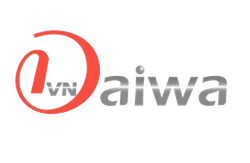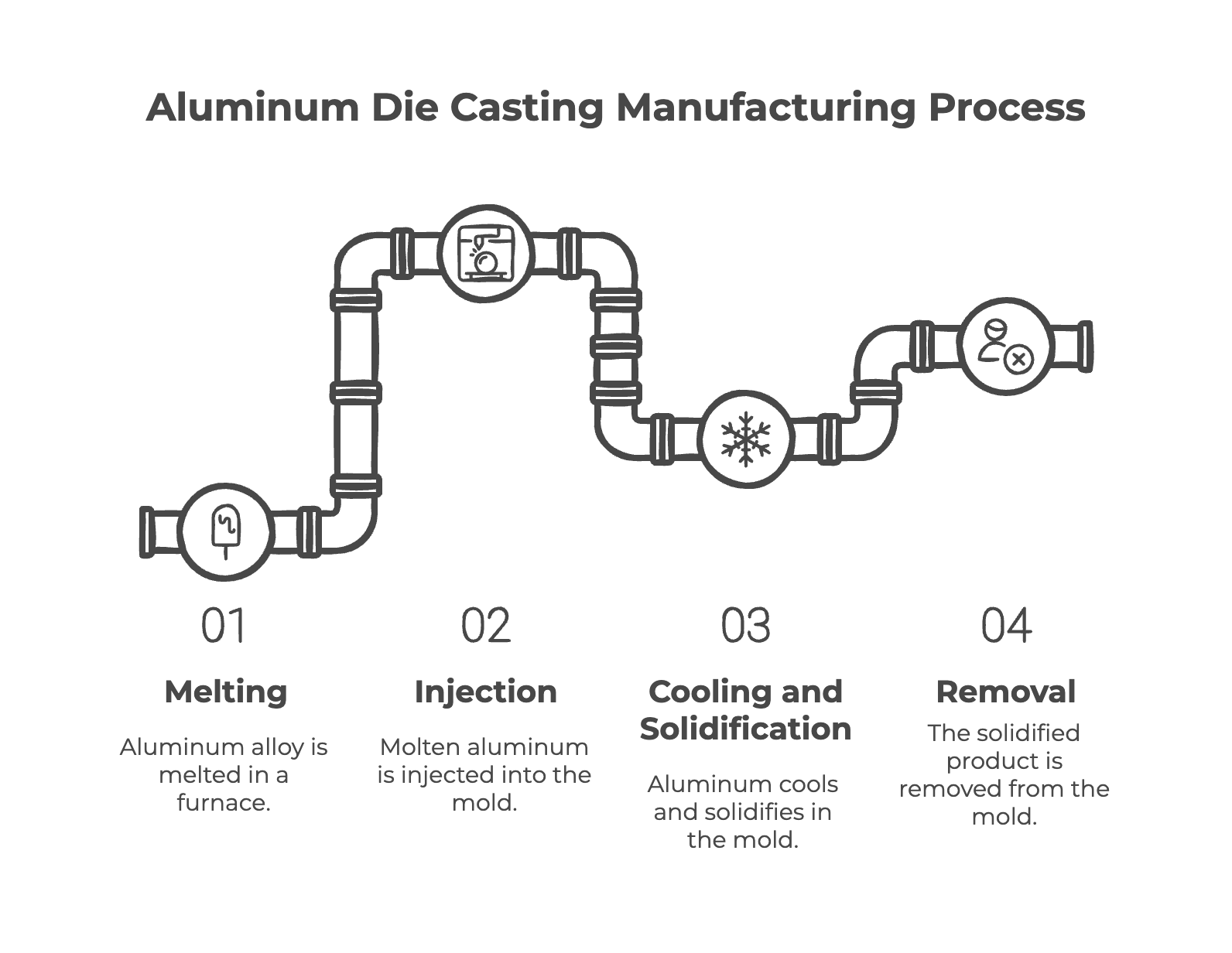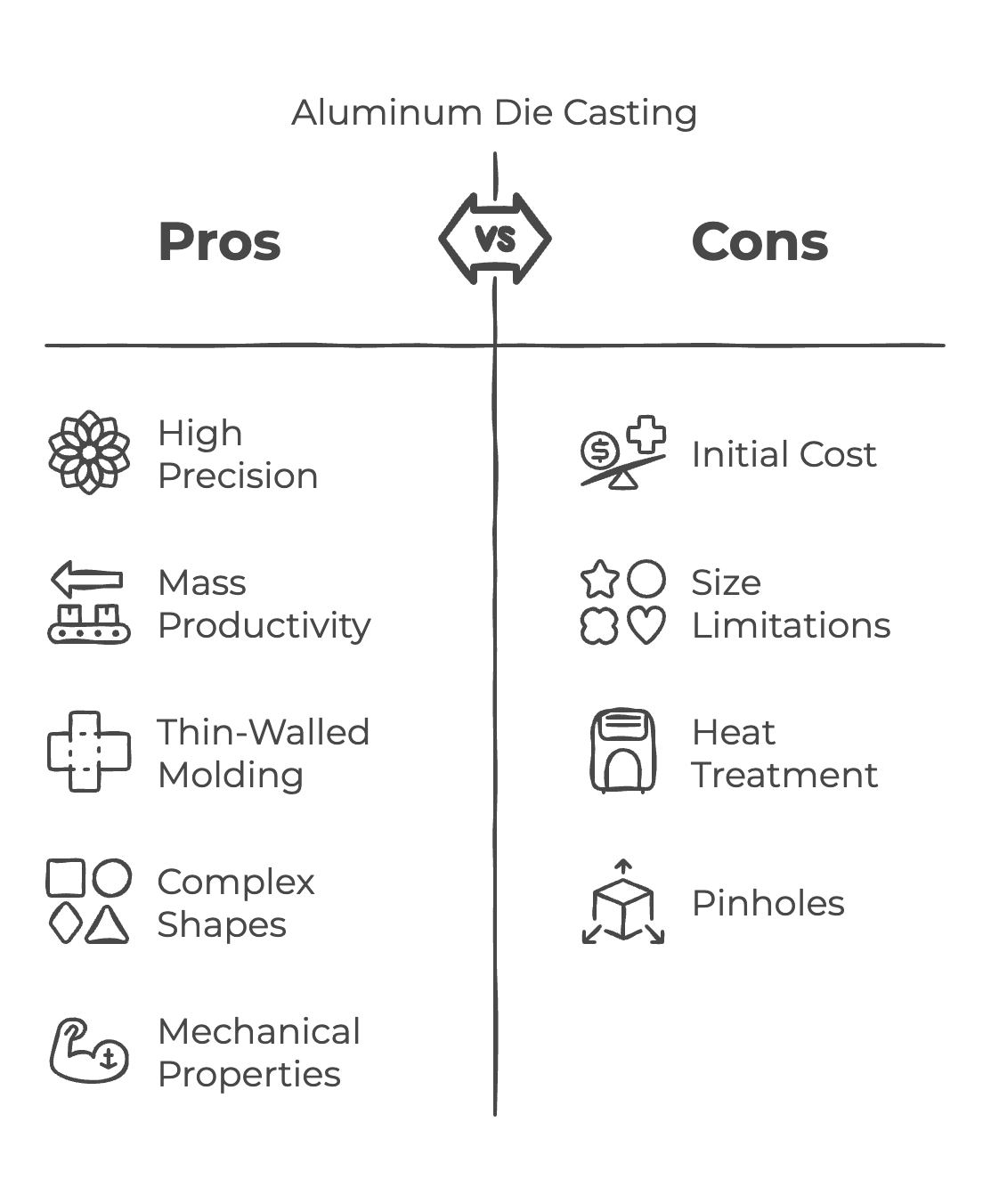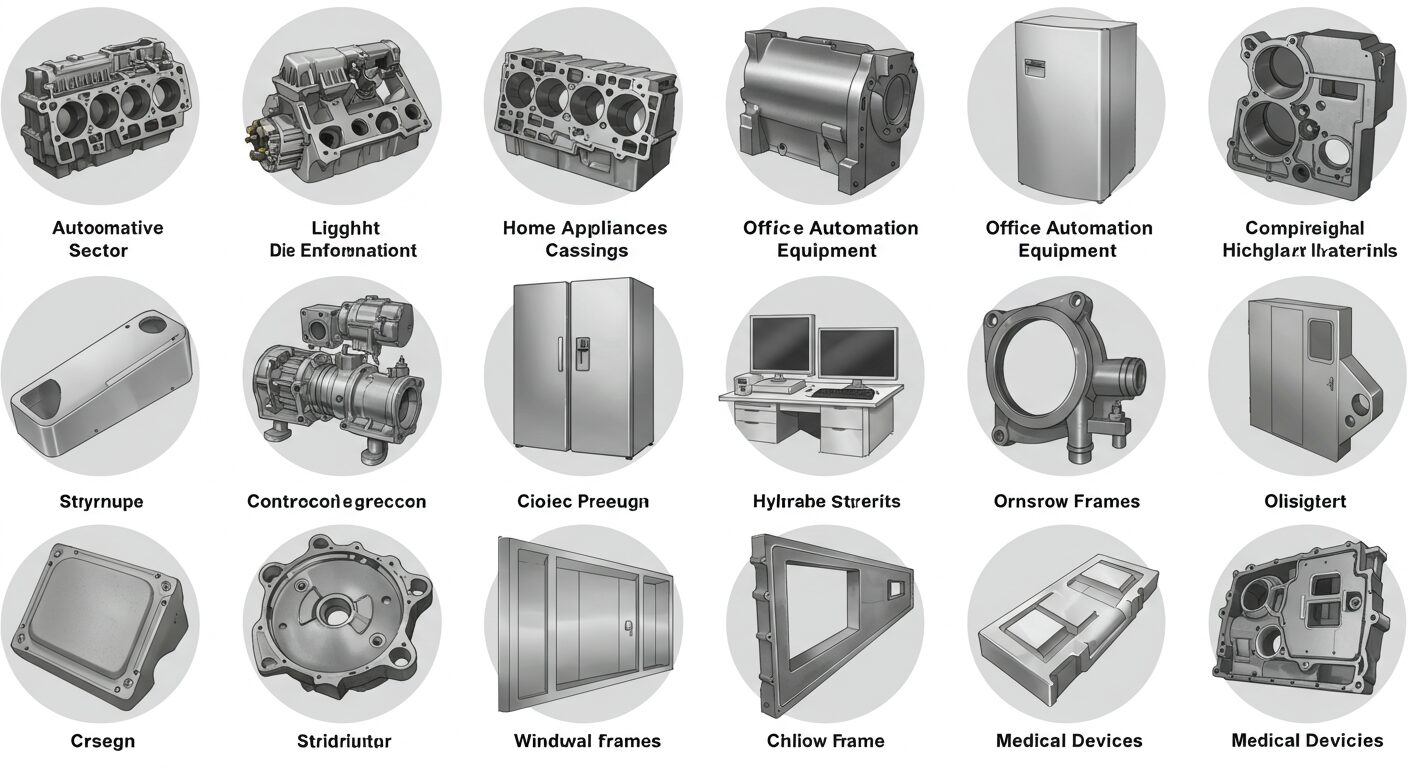◆Table of contents
ToggleIntroduction
Aluminum die casting, which is attracting attention among aluminum processing technologies, is a technology that efficiently forms various products by injecting molten aluminum alloy into a precision mold at high speed and high pressure. It contributes to weight reduction of automobile parts and improvement of design of home appliances, and supports our lives behind the scenes. This article thoroughly explains the basic knowledge, advantages and disadvantages, and uses of aluminum die casting. You will be able to deeply understand its potential. We will also introduce Daiwa Keikinzoku, which specializes in high-quality, low-cost product manufacturing.
Overview of Aluminum Die Casting
Definition and History of Aluminum Die Casting
Aluminum die casting is a type of casting method that injects molten aluminum alloy into a precision mold at high speed and high pressure to form it in a short time. This technology is used in various industrial fields because it can mass-produce products with high dimensional accuracy and smooth surfaces.
The history of die casting is old, and it is said that the die casting method using zinc alloy was developed in the United States in the late 19th century. After that, the aluminum alloy die casting method spread rapidly with the development of the automobile industry in the 1920s.
Aluminum Die Casting Manufacturing Process
The manufacturing process of aluminum die casting is roughly divided into the following four steps.
- Melting: Melt the aluminum alloy in a melting furnace and adjust it to an appropriate temperature.
- Injection: Inject the molten aluminum alloy into the mold at high speed and high pressure with a die casting machine.
- Cooling and Solidification: Rapidly cool and solidify the aluminum alloy in the mold.
- Removal: Remove the solidified product from the mold and perform finishing processes such as deburring as necessary.
These processes are performed at high speed and continuously, making them suitable for mass production.
Types and Characteristics of Aluminum Die Casting
Aluminum die casting is broadly divided into two types: cold chamber die casting machines and hot chamber die casting machines.
- Cold Chamber Die Casting Machine: A method in which molten aluminum alloy is put into an injection sleeve and pushed into a mold with a plunger. This method is generally used for aluminum alloy die casting.
- Hot Chamber Die Casting Machine: A method in which a molten metal tank is incorporated into a die casting machine and molten metal is injected directly into the mold. Used for zinc alloy die casting, etc.
Aluminum alloy die casting is excellent in lightweight, high strength, corrosion resistance, thermal conductivity, etc., and is used for various purposes.
Characteristics and Advantages of Aluminum Die Casting
Advantages of Aluminum Die Casting
Aluminum die casting has many excellent advantages due to its manufacturing method and the properties of aluminum alloys.
- High Precision and High Quality: By using precision molds and injecting molten metal at high speed and high pressure, it is possible to stably manufacture products with high dimensional accuracy and smooth surfaces.
- Mass Productivity: Suitable for mass production because of short cycle times and continuous production.
- Thin-Walled Molding: Contributes to weight reduction because thin-walled products can be molded.
- Compatibility with Complex Shapes: The number of parts can be reduced and the assembly process can be simplified because complex-shaped products can be integrally molded.
- Excellent Mechanical Properties: Mechanical properties such as strength, toughness, and corrosion resistance can be improved by adjusting the type of aluminum alloy and die casting conditions.
- Recyclability: Aluminum is easy to recycle and can reduce environmental impact.
Disadvantages of Aluminum Die Casting
On the other hand, aluminum die casting also has the following disadvantages.
- Initial Investment Cost: High costs are incurred for mold design and manufacturing, making it unsuitable for small-volume production.
- Moldable Size: There are limitations on the moldable product size depending on the mold size and die casting machine capacity.
- Heat Treatment: Aluminum die-cast products can improve their strength and corrosion resistance by heat treatment, but heat treatment requires additional cost and time.
- Pinholes: In the die casting process, air bubbles may be mixed into the molten metal, causing fine pores called pinholes. Pinholes can cause a decrease in product strength and airtightness.
It is important to consider the adoption of aluminum die casting after understanding these advantages and disadvantages.
Diverse Fields Where Aluminum Die Casting Plays an Active Role – Explanation of Application Examples
Aluminum die casting is used in a wide variety of fields due to its excellent properties. The following describes specific application examples and their advantages.
Automotive Parts
Aluminum die casting greatly contributes to the weight reduction and high performance of automobiles.
Engine Parts: Cylinder blocks, cylinder heads, oil pans, etc.
Advantages: Improved fuel efficiency due to weight reduction, improved engine performance due to high-precision casting
Transmission Parts: Mission cases, valve bodies, etc.
Advantages: Improved shifting performance due to weight reduction and increased strength
Wheels:
Advantages: Improved steering stability due to weight reduction, improved design
Other Parts: Chassis parts, brake parts, electrical parts, etc.
Home Appliances
Aluminum die casting contributes to weight reduction and improved design of home appliances.
Casings: Refrigerators, washing machines, air conditioners, televisions, etc.
Advantages: Weight reduction due to thin-walled molding, improved design due to compatibility with complex shapes
Parts: Motor parts, heater parts, etc.
Advantages: Improved performance due to high-precision casting, improved thermal conductivity
OA Equipment
Aluminum die casting contributes to the miniaturization, weight reduction, and high precision of OA equipment.
Casings: Personal computers, printers, copiers, etc.
Advantages: Miniaturization and weight reduction due to thin-walled molding, improved quality due to high-precision casting
Parts: Drive parts, mechanism parts, etc.
Advantages: Improved performance due to high-precision casting, improved durability
Industrial Machinery
Aluminum die casting contributes to the high performance and high reliability of industrial machinery.
Parts: Hydraulic parts, pump parts, valve parts, etc.
Advantages: Improved reliability due to high strength and high pressure resistance, improved performance due to high-precision casting
Building Materials
Aluminum die casting contributes to weight reduction and improved design of building materials.
Fittings: Doors, windows, handrails, etc.
Advantages: Improved workability due to weight reduction, improved design
Medical Equipment
Aluminum die casting contributes to the miniaturization, weight reduction, and high precision of medical equipment.
Casings: Inspection equipment, treatment equipment, etc.
Advantages: Improved operability due to miniaturization and weight reduction, improved quality due to high-precision casting
In this way, aluminum die casting is used in various fields by making use of its characteristics.
Selection Points for Aluminum Die Casting
When introducing aluminum die casting, you can select a more optimal product by considering the following points.
Material Selection
The properties of the aluminum alloy used for aluminum die casting vary depending on the type.
- ADC12: Excellent mechanical properties, machinability, and castability, and is the most common material.
- ADC6: Excellent corrosion resistance and is suitable for marine environments and chemical plants.
- ADC10: High strength and is suitable for automobile parts and industrial machinery parts.
It is important to select the appropriate aluminum alloy according to the product’s application and required properties.
Mold Design
The mold is an important factor that affects the quality of aluminum die-cast products.
- Structure: It is necessary to design the optimal mold structure considering the product shape, size, production volume, etc.
- Material: Generally, tool steel or cemented carbide is used for molds. It is important to select the appropriate material considering the durability and accuracy of the mold.
- Accuracy: The accuracy of the mold affects the dimensional accuracy and surface roughness of the product. High-precision molds must be used for products that require high accuracy.
Manufacturer Selection
The quality of aluminum die-cast products largely depends on the manufacturer’s technical capabilities and quality control system.
- Technical Capabilities: Check if they have advanced technologies and know-how regarding aluminum die casting.
- Quality Control System: Check if they have acquired quality control certifications such as ISO9001 and if they have a well-established quality control system.
- Production Capacity: Check if they have the production capacity to meet the required production volume.
It is important to comprehensively consider these points and select a reliable manufacturer.
Aluminum Die Casting by Daiwa Keikinzoku
Daiwa Keikinzoku contributes to solving customer problems by providing high-quality, low-cost aluminum die-cast products.
Cost Reduction Through Production in Vietnam
By establishing a production system in Vietnam, it has become possible to suppress labor costs and manufacturing costs, and to provide high-quality products at low cost.
High Quality Through Japanese-Style Management
Taking advantage of the Japanese-style management know-how cultivated over many years, we have built a thorough quality control system. We stably supply high-quality products and meet customer trust.
Local Procurement in Vietnam
By actively carrying out local procurement in Vietnam, we can reduce procurement costs and provide products to customers at low prices. In addition, by building a strong network with local suppliers, we have established a stable supply system.
Daiwa Keikinzoku utilizes these strengths to provide optimal solutions for customer needs.
Summary
Aluminum die casting is an indispensable technology in various industrial fields, with many advantages such as high precision, high quality, mass productivity, thin-walled molding, and complex shape support. It is used in products closely related to our lives, such as automobile parts, home appliances, and OA equipment. On the other hand, there are also issues such as initial investment costs, molding size, heat treatment, and pinholes, and technological development is underway to overcome them. With further technological innovation, weight reduction, high functionality, and cost reduction will progress, and the expansion of use is expected. Daiwa Keikinzoku provides optimal products by taking advantage of its strengths: cost reduction through production in Vietnam, high quality through Japanese-style management, and local procurement. Please feel free to contact us for consultation.



